Quck answer
Choosing the best window treatments for every room in the house involves considering the functionality, style, and privacy needs of each space. Start by identifying the purpose of the room and the amount of natural light it receives. For bedrooms and media rooms, opt for blackout curtains or blinds to block out light and ensure privacy. In living rooms and dining areas, choose window treatments that enhance the decor and allow for natural light control. Kitchens and bathrooms require moisture-resistant options like blinds or shutters. Consider the overall style of the room and select window treatments that complement the existing decor.
When it’s time to update the window treatments in your home, it can be overwhelming to navigate through the various options available. From cornices to wood blinds to Roman shades, there are so many choices to consider. However, by evaluating the form and function of each type and matching it to your specific needs for each room, you can narrow down your options and make the best decision.
Factors to Consider when Choosing Window Treatments
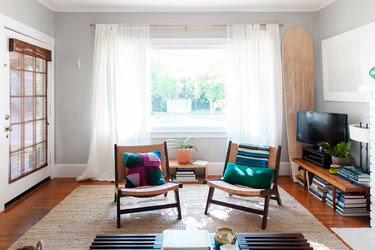
Image Credit:
Codi Ann Backman
There are several factors to take into account when selecting window treatments, from their functionality to their appearance. Consider how you utilize each room to determine which of these factors are most relevant.
Aesthetics of Window Treatments
When choosing window treatments, style is usually one of the primary considerations. Since windows occupy a significant portion of your exterior walls, the window treatments can have a significant impact on the overall design of the room. Take into account the overall style, colors, and design elements to select window treatments that coordinate well. In a formal space, ornate drapes may be the ideal choice, while Roman shades or wood blinds might be more suitable for a casual or minimalist look.
Neutral tones are popular for window treatments as they complement other pieces of home decor. If you want to add a pop of color, drapes and curtains are available in a wide range of colors and patterns. Choose a shade that complements the rest of your decor if you decide to go for a colorful option. If you’re unsure about what to choose, an interior designer can evaluate your decor and provide window treatment recommendations.
Budget Considerations for Window Treatments
It’s important to establish your budget before you start shopping for window treatments. The cost of window treatments can vary greatly, from inexpensive off-the-shelf blinds in standard sizes to high-end custom-made coverings with a hefty price tag.
Determine your overall budget for window treatments and count the number of windows you need to cover. This will help you allocate your funds and narrow down your search. You may choose to invest more in window treatments for your living room and other shared spaces, where more people will see them, as opposed to your primary bedroom, where only you will be looking at them.
Light Filtration and Control
Window treatments offer a range of light filtration options, from sheer curtains that allow ample light to blackout shades that create complete darkness, perfect for sleeping. The level of opacity you choose depends on the purpose of the room. Opting for window treatments that block sunlight can help keep your room cooler and darker.
Common levels of light control include:
- Sheer: This type of fabric is lightweight and allows you to see out your window even when the covering is closed. However, it offers almost no privacy. You can pair it with another layer for more flexibility.
- Light filtering: Slightly more opaque than sheer, this option blocks the view but still allows you to see silhouettes. It provides a good mix of privacy and light for common areas like living rooms.
- Room darkening: Falling between light filtering and blackout, this option offers a high level of privacy without total darkness. It lets a small amount of light through but keeps the room dark enough for comfortable sleep.
- Blackout: Designed to block all light from the room, blackout window treatments provide the highest level of privacy and insulation. However, some light may filter in around the edges if not installed properly. They are ideal for bedrooms, nurseries, and theater rooms.
Opening Movement and Method
Window coverings can open up and down, to the side, or by tilting. Roman shades, roller shades, pleated shades, and cellular shades move up and down to control the light. Curtains, drapes, and vertical blinds move to the side to allow more light. Certain types of blinds, like wood and metal blinds, tilt to let in light or can be raised up and down.
The opening mechanism is also a consideration. Corded and cordless blinds are available. Cordless blinds are usually opened by pushing up from the bottom and closed by pulling down. Tilting blinds often have a rotating wand to open and close them.
Insulation
Window coverings can add an insulating layer to your windows, helping to regulate the temperature in your room. Thermal window coverings can make your room more comfortable and reduce the need for heating or cooling. Cellular shades are a good choice for energy efficiency as their cell pockets trap air to insulate. Lined drapes also provide insulation. Look for window treatments that are labeled as energy efficient or thermal.
Exterior View
Consider the view from outside when selecting window treatments. If you live in a community with strict homeowners’ association rules, check if there are any regulations regarding window treatments. Some homeowners’ associations require white window coverings on the exterior side to maintain a consistent look among homes.
Even if you don’t have any restrictions from HOA, it’s still worth considering how your window treatments look from the street or sidewalk. Having a consistent appearance, especially for the windows facing the street, can enhance curb appeal. While white is a safe and neutral option, wood tones also offer a neutral appeal. If each window has a different type of covering, it can be very noticeable and distracting.
Ensuring Window Treatment Safety
Window treatments with cords pose a common safety hazard in homes due to the risk of strangulation. If you have kids or pets, it’s best to opt for cordless options. Not only do they eliminate the risk of strangulation, but they also give your windows a sleek and tidy look while avoiding the tangling that can occur with cords.
Considering Ease of Care
Your window treatments tend to attract dust, so regular cleaning is necessary to keep them looking their best. When considering your options, think about the ease of cleaning. If you prefer curtains or drapery panels, check the care instructions to see if they can be machine-washed or if they require dry cleaning. If you prefer blinds, faux wood is a durable material that can handle moisture better than real wood, making them easier to clean.
Special Considerations for Doors
Choosing window treatments for sliding doors requires some additional thought since you need frequent access to the door. A common solution is to install vertical blinds because they can easily slide to the side when you want to use the door. Additionally, you can adjust the slats to let in some light without fully opening the blinds on sliding glass doors.
Guide to Window Treatments for Each Room
The best window treatments for each room should address the specific concerns of that area. For instance, in common spaces, you may want to maximize natural light to create a warm and welcoming atmosphere. In bedrooms and bathrooms, privacy is a priority.
Window Treatments for the Living Room
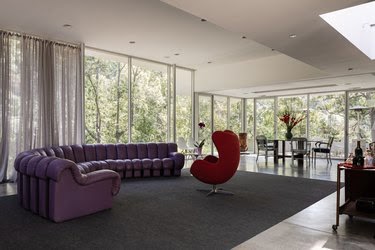
Image Credit:
Stephen Paul for Hunker
Window treatments for the living room or family room offer more flexibility compared to other spaces. Privacy is not as important, although you might want thicker window coverings for nighttime. In the living room, the main focus is on the appearance since it is a space that guests will see. Drape panels are often used to add texture and color. Layering them with sheers allows for a bright and sunny living room during the day and more privacy at night. This option works well for large windows in the living room, as blinds or shades for large windows can be costly and challenging to use.
For a casual living room, various types of shades are suitable. Cellular, Roman, and roller shades can easily be opened and closed to adjust the lighting. Wood blinds add warmth and texture to the living room. If desired, you can soften the look of blinds by adding curtain panels or a window valance on a curtain rod.
Window Treatments for a Home Theater
Visit Page
https://go.skimresources.com
Image Credit:
Walmart
You’ve carefully chosen the perfect recliners and a cutting-edge projector for your home theater room, but have you considered the window treatments? Even a small amount of natural light can ruin the movie theater atmosphere and cause glare on the screen. Opt for blackout curtains or layered window coverings that completely block out all light for the best movie experience at home.
Window Treatments for the Kitchen
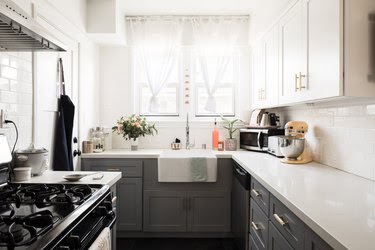
Image Credit:
Stephen Paul for Hunker
Create a stylish look for your kitchen with suitable window treatments that complement the space and take into account the specific concerns of a cooking area. Avoid using long, flowing curtains in the kitchen, especially near the stove where they can pose a fire hazard. Drapes can also obstruct windows above sinks or countertops.
Roman or woven shades provide a practical choice for kitchens, adding a touch of texture. If you prefer the appearance of curtains, opt for short, cafe-style curtains as long as they are not placed near the stove. Choose something that is easy to clean or wipe with a damp cloth, as kitchen window coverings can get splattered with food or grease. Aluminum or faux wood blinds and vinyl roller shades are both durable and washable.
Window Treatments for the Dining Room
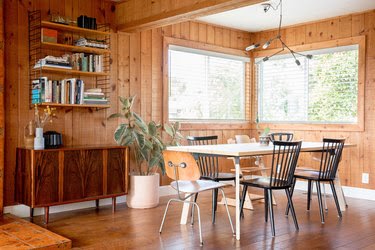
Image Credit:
Sanford Creative
Privacy is usually not a major concern in the dining room, and you do not have to worry about open flames like in the kitchen, giving you more flexibility in selecting window treatments. If your dining room is connected to the kitchen or living room, maintaining the same window treatments or coordinating them in some way can create a cohesive look. Otherwise, choose drapes, shades, or blinds that match the desired level of light filtration and complement the aesthetics of the dining room, whether it be minimalist or formal.
Window Treatments for the Home Office

Image Credit:
Describe the Fauna
Consider your preferred working style when choosing window treatments for a home office. If you enjoy natural light, sheers can slightly block the view to minimize distractions while keeping the space bright. Wood blinds are also a suitable option as you can adjust the slats to allow in light while blocking the view, helping you focus on your work instead of what is happening outside your window.
Window Treatments for the Bedroom
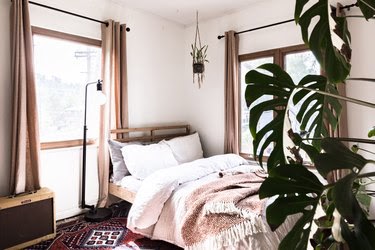
Image Credit:
Stephen Paul for Hunker
Your bedroom is a sanctuary where you want to relax and sleep soundly. Privacy is also a significant concern in this area. These factors make blackout curtains or room-darkening blinds a popular choice for bedroom window treatments. Layering drapes is also an effective solution. In addition to creating a dark sleeping environment, these lined window coverings help insulate your room, maintaining a comfortable temperature for improved sleep.
Window Treatments for the Bathroom

Image Credit:
Tony Puerzer
The steamy showers and long bubble baths you indulge in to unwind after a stressful day increase the humidity in your bathroom. Choosing the wrong type of material can shorten the lifespan of your window coverings. For instance, wood blinds may warp or bend due to the moisture. However, faux wood blinds or water-resistant window coverings are a suitable choice for bathrooms. Roller shades are an option, but vinyl is typically better than fabric as fabric can develop mold or mildew in a humid bathroom.

